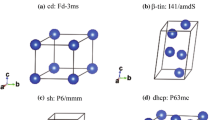Abstract
High-frequency (HF) conductivity in systems with a dense (with a density of n = 3 × 1011 cm−2) array of self-organized Ge0.7Si0.3 quantum dots in silicon with different boron concentrations n B is determined by acoustic methods. The measurements of the absorption coefficient and the velocity of surface acoustic waves (SAWs) with frequencies of 30–300 MHz that interact with holes localized in quantum dots are carried out in magnetic fields of up to 18 T in the temperature interval from 1 to 20 K. Using one of the samples (n B = 8.2 × 1011 cm−2), it is shown that, at temperatures T ≤ 4 K, the HF conductivity is realized by the hopping of holes between the states localized in different quantum dots and can be explained within a two-site model in the case of

, where ω is the SAW frequency and τ0 is the relaxation time of the populations of the sites (quantum dots). For T > 7 K, the HF conductivity has an activation character associated with the diffusion over the states at the mobility threshold. In the interval 4 K < T < 7 K, the HF conductivity is determined by a combination of the hopping and activation mechanisms. The contributions of these mechanisms are distinguished; it is found that the temperature dependence of the hopping HF conductivity approaches saturation at T* ≈ 4.5 K, which points to a τ0 ≤ 1. A value of τ0(T*) ≈ 5 × 10−9 s is determined from the condition ωτ0(T*) ≈ 1.
Similar content being viewed by others
References
A. I. Yakimov, A. V. Dvurechenskii, V. V. Kirienko, et al., J. Phys.: Condens. Matter 11, 9715 (1999); Phys. Rev. B 61, 10868 (2000).
I. L. Drichko, A. M. Diakonov, V. I. Kozub, et al., in Proceedings of 11th International Symposium on Nanostructure: Physics and Technology (Ioffe Physicotechnical Inst., St. Petersburg, 2003), p. 133.
G. R. Nash, S. J. Bending, M. Boero, et al., Phys. Rev. B 59, 7649 (1999).
A. Knäbchen, O. Entin-Vohlman, Y. M. Galperin, and Y. B. Levinson, Europhys. Lett. 39, 419 (1997).
A. I. Yakimov, A. V. Dvurechenskii, G. M. Min’kov, et al., Zh. Éksp. Teor. Fiz. 127, 817 (2005) [JETP 100, 722 (2005)].
I. L. Drichko, A. M. Diakonov, I. Yu. Smirnov, et al., Phys. Rev. B 62, 7470 (2000).
A. L. Efros and B. I. Shklovskii, in Electron-Electron Interactions in Disordered Systems, Ed. by A. L. Efros and M. Pollak (North-Holland, Amsterdam, 1985), p. 409; Y. M. Galperin, V. L. Gurevich, and D. A. Parshin, in Hopping Transport in Solids, Ed. by B. Shklovskii and M. Pollak (Elsevier, New York, 1991), p. 453.
Yu. M. Gal’perin and É. Ya. Priev, Fiz. Tverd. Tela (Leningrad) 28, 692 (1986) [Sov. Phys. Solid State 28, 385 (1986)].
B. I. Shklovskii and A. L. Éfros, Electronic Properties of Doped Semiconductors (Nauka, Moscow, 1979; Springer, New York, 1984), p. 416.
J. Zhang and B. I. Shklovskii, Phys. Rev. B 70, 115317 (2004).
I. S. Beloborodov, A. V. Lopatin, V. M. Vinokur, and V. I. Kozub, cond-mat/0501094.
M. V. Feigel’man and A. S. Ioselevich, Pis’ma Zh. Éksp. Teor. Fiz. 81, 341 (2005) [JETP Lett. 81, 277 (2005)].
V. I. Kozub, V. M. Kozhevin, D. A. Yavsin, and S. A. Gurevich, Pis’ma Zh. Éksp. Teor. Fiz. 81, 287 (2005) [JETP Lett. 81, 226 (2005)].
Yu. M. Gal’perin, I. L. Drichko, and L. B. Litvak-Gorskaya, Fiz. Tverd. Tela (Leningrad) 28, 3374 (1986) [Sov. Phys. Solid State 28, 1899 (1986)].
I. L. Drichko, A. M. D’yakonov, I. Yu. Smirnov, and A. I. Toropov, Fiz. Tekh. Poluprovodn. (St. Petersburg) 34, 436 (2000) [Semiconductors 34, 422 (2000)].
Author information
Authors and Affiliations
Additional information
__________
Translated from Zhurnal Éksperimental’no\(\overset{\lower0.5em\hbox{$\smash{\scriptscriptstyle\smile}$}}{l}\) i Teoretichesko\(\overset{\lower0.5em\hbox{$\smash{\scriptscriptstyle\smile}$}}{l}\) Fiziki, Vol. 128, No. 6, 2005, pp. 1279–1287.
Original Russian Text Copyright © 2005 by Drichko, D’yakonov, Smirnov, Suslov, Gal’perin, Yakimov, Nikiforov.
Rights and permissions
About this article
Cite this article
Drichko, I.L., D’yakonov, A.M., Smirnov, I.Y. et al. Mechanisms of low-temperature high-frequency conductivity in systems with a dense array of Ge0.7Si0.3 quantum dots in silicon. J. Exp. Theor. Phys. 101, 1122–1129 (2005). https://doi.org/10.1134/1.2163927
Received:
Issue Date:
DOI: https://doi.org/10.1134/1.2163927




